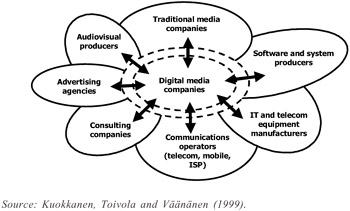Finland as a Mobile Business Pioneer
|
The Finnish telecom industry dates back to 19th century, when the first telecom networks were built in the country, initiated by the Russian Czar and the Finnish autonomous government. Until the 1980s, because of limited capital resources available in the country, local telecom companies and cooperatives dominated the Finnish telecommunications markets. Yet, the nearly 300 local telephone companies had talented personnel, and Finland's telecom industry, led by the national monopoly company Telecom Finland, [1] gradually developed one of the most sophisticated networks in Western Europe. Liberalization and digitization of the telecom network, strongly initiated and steered by the Finnish government, boosted the sophistication of the networks.
Telecommunications rose in importance for the Finnish economy throughout the 1990s. In Table 1, the rapid growth in importance of telecommunications for the economy is shown. Telecommunications represented only 2% of total Finnish GDP in 1990, but by 2000, this had doubled to about 4% of the economy. During the same period, mobile phone penetration rose from a mere 5% to over 70% of the Finnish population.
Table 1: Rapid Growth of Finnish Telecommunications Industry
| Telecommunications Industry in Finland | 1990 | 1995 | 2000 |
|---|---|---|---|
| Total turnover of telecom companies, mEUR | 1428 | 1861 | 4364 |
| Telecom turnover as % of GDP | 2% | 3% | 4% |
| Personnel in the telecom industry | 20,067 | 16,405 | 24,204 |
| Subscriptions | 1990 | 1995 | 2000 |
|---|---|---|---|
| Fixed-network subscriptions, total | 2,670,000 | 2,810,000 | 2,848,000 |
| Fixed-network subscribers/100 inhabitants | 53.4 | 55.0 | 55.0 |
| Mobile-network subscriptions, total | 257,872 | 1,039,126 | 3,728,625 |
| Mobile-network subscribers/100 inhabitants | 5.2 | 20.4 | 72.0 |
| Public telephones, total | 20,229 | 25,267 | 12,427 |
| Public telephones/100 inhabitants | 0.4 | 0.5 | 0.2 |
| Household information | 1990 | 1995 | 2000 |
|---|---|---|---|
| Internet connections/100 households | — | — | 31.6 |
| Computers/100 households | — | — | 48.2 |
| Fixed-network subscriptions/100 households | 131.1 | 128.8 | 124.1 |
| Mobile phones/100 households | 12.7 | 47.6 | 162.5 |
| Selected demographic information about Finland | 1990 | 1995 | 2000 |
|---|---|---|---|
| Population | 4,998,000 | 5,117,000 | 5,176,000 |
| GNP, mEUR (market price) | 87,967 | 94,953 | 132,038 |
| Consumer price index (1995 = 100) | 100 | 108 | |
| Source: Ministry of Communications and Transport, Finland, 2002. | |||
By the end of the 20th century, Finland became one of the leading countries in mobile communications. Nearly 78% of Finns had a mobile phone in 2001, and the market neared the point of saturation (Lepp vuori, 2002). Among certain segments, e.g., teenagers and the business community, the penetration was nearly 100%. Public telephones have become obsolete, as nearly every-one has a personal portable phone. People moving into an apartment or a house often forego a fixed connection and subscribe only to the mobile network. The traditional fixed phone line is used mainly for high-speed Internet connections rather than for voice communications. [2]
The telecommunications sector also forms an essential part of the Finnish ICT-cluster. [3] Presented in Figure 1 is the structure of the various converging industries, ranging from media to traditional telecommunications. Digital service companies constitute the core of the cluster. Digitization of information had dramatic impacts on end users and ICT companies. Digitization allowed ICT firms to start producing and offering innovative services that were totally new to end users, increased the geographical reach of existing digital and offline services, and offered cost-cutting opportunities for organizations adopting new digital technologies. Finnish companies are also actively building the digital communications infrastructure and developing new services.

Figure 1: Generic Model of ICT-Cluster
In 1999, the total turnover of the Finnish ICT cluster was estimated to be 34 billion euros (nearly 25% of Finnish GDP), and the ICT-related activities employed around 146,000 people (about 6% of the total workforce) (Table 2).
| Manufacturing | Service Creation | Communication Services | Content Production | |
| Turnover (in euros) |
|
|
|
|
| Personnel |
|
|
|
|
| Key products and services |
|
|
|
|
| Total ICT cluster in Finland |
| |||
| Source: Merist , Leppim ki and Tammi (2002). | ||||
In recent years, mobile telecommunications has been one of the most rapidly developing sectors within ICT. Finnish companies as well as users have been very open to modern technology, and Finland has become an interesting lead market for mobile development. By 2000, several venture capitalists began investing in Finnish start-up companies to explore and learn about possibilities in the mobile markets. In the next section, we look in detail at the structure of the Finnish mobile telecom markets.
[1]In its early years, like most other telecom firms worldwide, Telecom Finland (TF) operated as a division of the Finnish national post office. TF changed its name to Sonera in 1997. Now, Sonera and Sweden's Telia merged.
[2]The U.S.-based author of this chapter had an interesting experience in Helsinki in 2000. From his apartment in Helsinki, the author called the mobile phone of a Nokia executive. The Nokia executive said: "I was surprised to get this call. I hardly ever get a call from a fixed line!"
[3]ICT refers to Information and Communications Technologies.
|
EAN: 2147483647
Pages: 139